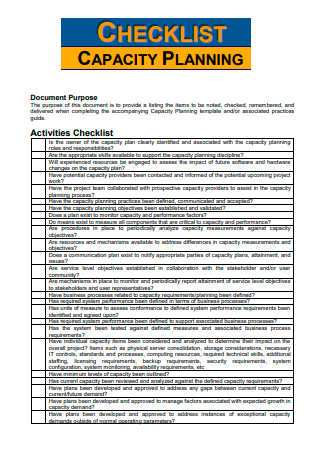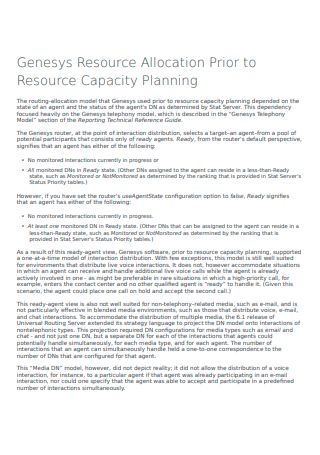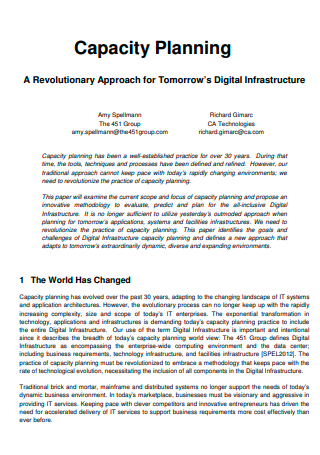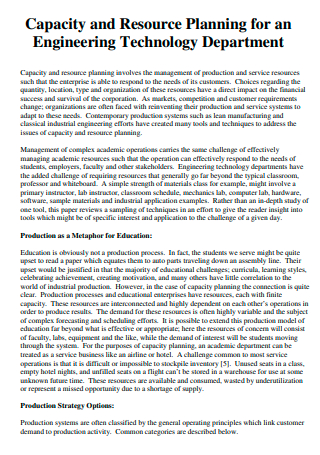The sales and marketing departments of a business play a vital role in ensuring the continuous successes of the company or establishment especially when it comes to its sustainability.…
continue reading
20+ SAMPLE Capacity Planning
-

Capacity Planning Template
download now -

Long-Term Capacity Planning
download now -

Capacity Planning Checklist
download now -

Capacity Planning Example
download now -

Tent Capacity Planning Chart
download now -

Sales Capacity Planning
download now -

Water Capacity Development and Planning
download now -

Demand and Capacity Planning
download now -

Resource Capacity Planning
download now -

Capacity Planning Manager
download now -

Investment and Capacity Planning
download now -

Non-Stop Server Capacity Planning
download now -

Strategic Capacity Planning
download now -

Capacity Planning in PDF
download now -

Capacity and Resource Planning For an Engineering Technology Department
download now -

Management and Capacity Planning
download now -

Logistics Capacity Planning
download now -

Printable Capacity Planning
download now -

Standard Capacity Planning
download now -

Capacity Planning and Performance
download now -

Sub-Capacity Planning
download now
What Is Capacity Planning?
Capacity planning is how organizations determine the amount of work they can accomplish given their total employee count and upcoming time constraints. More precisely, “capacity” refers to the maximum amount of work that can be accomplished in a specified amount of time. Capacity is frequently expressed in terms of employee work hours. And “planning” in this context refers to the act of allocating employee hours to a fixed or anticipated amount of work. According to studies, 69% of surveyed organizations believe agile methods help them better manage changing priorities, while 65% report increased project visibility. Transparency of work and resources and the ability to adapt quickly are critical components of effective capacity planning.
Benefits of Capacity Planning
If you’re looking for the primary advantage of capacity planning, you’ll find quite a few! Businesses that implement a capacity planning methodology to improve efficiency and meet demand may reap some or all of the following benefits.
Tips To Improve Capacity Planning
Capacity planning is a never-ending task in an ever-changing contact center environment. However, there are strategies and techniques that every manager may use to increase the likelihood of success. Several of our readers provide their advice and recommendations for attaining the best outcome in this section.
1. Don’t Change Forecasts to Meet Goals
When planning capacity, it is vital to act as (and be perceived as) a guardian of the truth. It’s beneficial to establish excellent behaviors here. For instance, admitting your errors and taking responsibility for them. Avoid altering history to rationalize anomalies or alter your forecast to fulfill targets. You will jeopardize your professional reputation if you are detected, but you will also miss out on precious opportunities to learn and improve in the future.
2. Avoid Spreadsheets in Plan Presentation
With so many figures and influencing elements at play, it’s easy to become mired in the minutiae. This can be perplexing and may send mixed messages to the team. Rather than that, be specific about your objectives and avoid using spreadsheets when discussing your goals. Additionally, taking the time to explain things, respond to inquiries, utilize visual aids to outline your goals, and share additional information with your team following meetings will assist.
3. Convince Your Audience With Facts and Confidence
When it comes to capacity planning, there is no space for speculation. Always make decisions based on the information at hand. Additionally, it helps to share some of these rationales with your team – while being careful not to overcomplicate things – so they grasp the “why” and not simply the “how.” This will enable you to communicate your intentions confidently and gain greater buy-in in the long run.
4. Take Note of What Your Agents Have to Say
Often, your agents will be an excellent source of information about what is truly going on on the contact center floor. Additionally, they may have beneficial suggestions for enacting constructive change. It is also critical to be approachable and personable (avoid a policing mentality) while still providing structured chances for regular input on the good, the terrible, and the ugly. Your agents will gradually develop a sense of empowerment, and sharing ideas and insights will become a cultural standard. Your capacity planning will be much improved as a result!
5. Treat Everyone Equally
Specific contact centers have policies that offer preference to long-term employees or high achievers. This, however, can breed hatred and result in preferred shift patterns being denied to those in most need. This can also result in a turnover if shifts are frequently inconsistent with agents’ lifestyle requirements. Rather than that, managers should prioritize fairness and devising solutions that benefit everyone on their team — even those who have recently joined.
6. Highlight Planning Process Wasted Time and Weaknesses
When attempting to make a case for positive change, it can be beneficial to emphasize areas of inefficiency in the current process. For instance, if you’re considering switching to preference-based scheduling, why not consider how much time planners waste on shift swaps and attempting to accommodate agents changing shifts?
How To Create a Capacity Planning Process
Are you attempting to balance technological infrastructure and demand? The seven critical steps are involved in conducting an effective capacity planning process.
1. Choose a Capacity Planning Process Owner
The first step in building a comprehensive capacity planning process is to appoint a process owner who is adequately qualified. This individual is accountable for the process’s design, implementation, and maintenance and has the authority to negotiate and delegate with developers and other support groups. First, this professional must be adept at communicating with developers, as much of the effectiveness and credibility of a capacity plan is contingent on accurate input and constructive feedback from developers to infrastructure planners. Additionally, this individual must have a working knowledge of systems and network software and components and software and hardware settings. Depending on the applications and services offered, these characteristics and their relative importance vary significantly.
2. Determine the Critical Resources to Be Measured
Once the process owner is determined, one of the first duties assigned to him or she is to identify the infrastructure resources whose usage or performance must be measured. This assessment is based on current knowledge of the most crucial resources for achieving future capacity needs. In many workplaces, these resources are defined by network bandwidth, the number and speed of server processors, or the number, size, and density of disk volumes that comprise centralized secondary storage.
3. Measure the Resources’ Utilization or Performance
The usage or performance of the resources indicated in Step 2 should now be quantified. Two critical pieces of information are obtained from these measurements. For instance, a crucial server may run at an average of 60% usage during daily peak periods. Weekly and monthly averages and plots of these daily figures enable trend analysis. Typically, resource consumption is quantified using a variety of different approaches. Each tool adds a unique dimension to the overall usage matrix. A single tool may provide information on CPU and disk channel use. Another may provide information on disk space utilization; a third may provide information about how much of that space is used by databases.
4. Contrast Utilization to Capacity Maximums
This exercise aims to ascertain the extra capacity available for selected components. Each component’s utilization or performance should be compared to its maximum usable capacity. It’s worth noting that the highest usable capacity is almost always less than the maximum theoretical capacity. For example, the maximum useable capacity of a server is often between 80% and 90%. Similarly, network bandwidth and cache store hit ratios are constrained. By extrapolating utilization trends information and comparing them to the maximum usable capacity, the process owner should now be able to anticipate when a specific resource’s excess capacity is likely to be exhausted.
5. Collect Forecasts of Developers’ and Users’ Workloads
This is a vital step in the capacity planning process and one over which you have the least control. Typically, developers are tasked with assisting users in completing IT workload projections. As is often the issue with this type of operation, the outcome is only as good as the input. Collaborating with developers and a few select pilot users to create a basic yet effective spreadsheet can significantly ease this phase.
6. Workload Forecasts into IT Resource Needs
After collecting workload projections, the expected changes must be converted to IT resource requirements. Sophisticated measurement tools or the experience of a senior analyst can assist in translating predicted transaction loads, for example, into greater server processor capacity. Additionally, the worksheets enable you to project the projected periods for workload growth. It is prudent to leverage the performance centers offered by leading vendors of servers, database software, and enterprise applications for large application workloads.
7. Connect requirements to existing uses
The estimated resource requirements generated from the users’ workload estimations in Step 6 are now plotted on the excess utilization charts created in Step 4. This map illustrates the additional capacity required by each component to satisfy the anticipated demand.
FAQs
What are the concepts underlying capacity planning?
It refers to the maximum amount of output obtained during a specific time. It refers to the optimal degree of output in light of changes in product mix, equipment maintenance, programming, operating issues, and labor issues, among other factors. Typically, it is smaller than the entire capacity of the design.
Capacity planning is quantified in what way?
It is defined as the number of units an operation can create during a specified time while operating under normal operating conditions and without deploying additional resources. Typically, capacity is expressed in practical measures such as liters per hour or people per taxi.
What is the definition of effective capacity?
The adequate capacity of a storage device is the amount of storage allocated to applications. When thin-provisioned storage architectures are used, the adequate capacity of the array is nearly double that of the array’s usable capacity. This is accomplished by either overcommitting capacity or compressing the data served.
Capacity planning will never be perfect in knowledge work, but it is critical to ensure your business gets the most value from its people and teams. This iterative planning practice is critical for decision-making. Regardless of the methods used, the goal is to maintain a balance between capacity and demand in the face of ongoing change. The critical aspect to remember is that capacity planning is an ongoing activity that frequently assesses your current capacity and compares it to your future requirements. With more visibility into both work and resources/teams, you’ll be able to prioritize and manage workloads more effectively, ensuring that you meet your strategic plans.


